HC2121 - Ethical Issues in Business: Case Study of Wells Fargo Scandal
VerifiedAdded on 2023/06/11
|8
|1958
|267
Essay
AI Summary
This essay delves into the Wells Fargo scandal, examining the ethical issues surrounding the creation of fraudulent accounts and the company's subsequent response. It summarizes the arguments presented in a recent news article, including the background, history, and legal implications of the scandal. The essay critically discusses the key ethical concerns, such as corporate governance and social responsibility, raised by the case. It evaluates the appropriateness of the ethical decisions made by Wells Fargo, comparing them to other ethical cases and considering the reasonableness of imposed sanctions. Furthermore, the essay outlines an ethical decision-making process, aligning the author's opinion with one of the seven moral philosophies discussed in the class textbook. The conclusion emphasizes the importance of ethical reward systems and proactive problem-solving in preventing future crises.
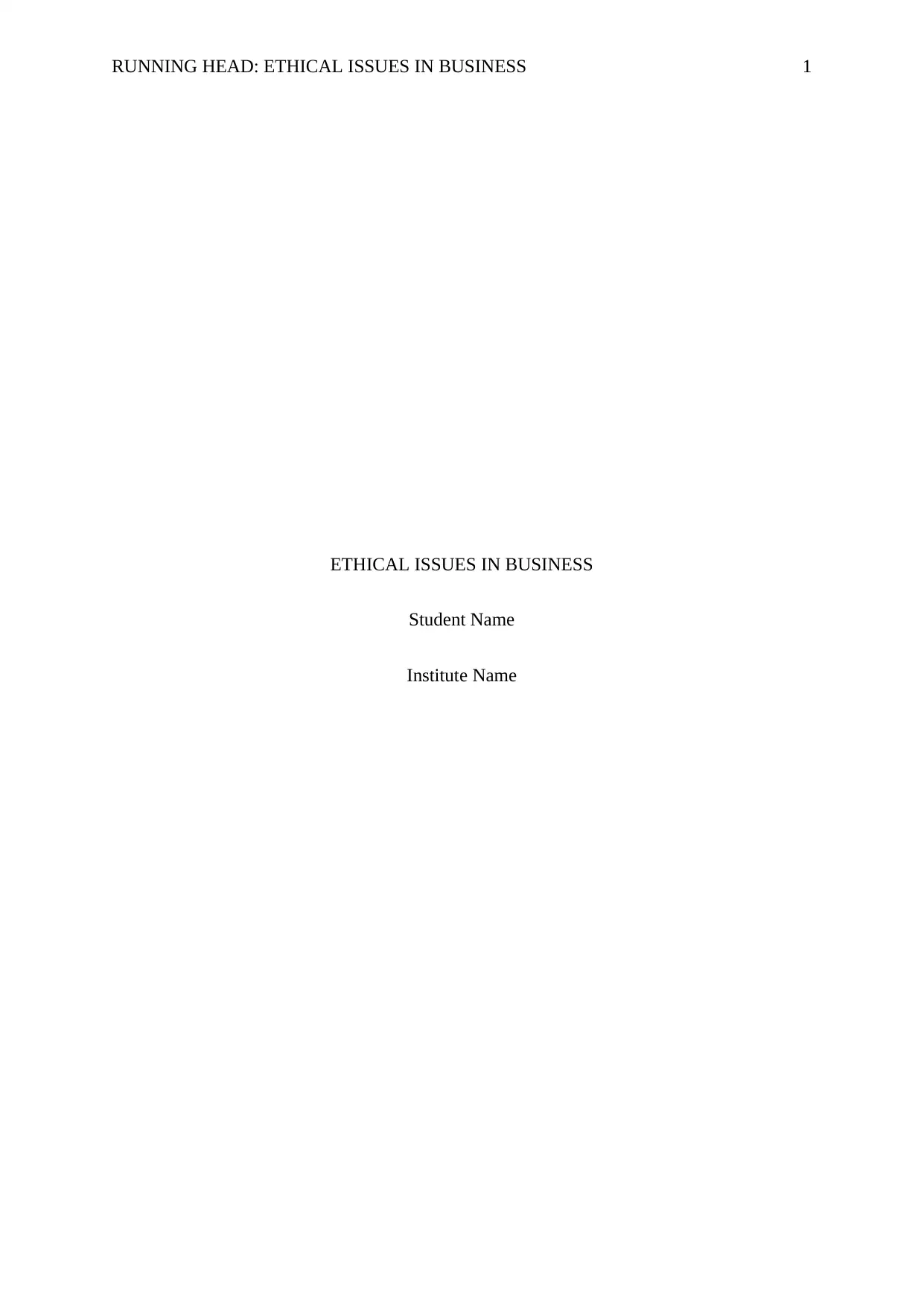
RUNNING HEAD: ETHICAL ISSUES IN BUSINESS 1
ETHICAL ISSUES IN BUSINESS
Student Name
Institute Name
ETHICAL ISSUES IN BUSINESS
Student Name
Institute Name
Paraphrase This Document
Need a fresh take? Get an instant paraphrase of this document with our AI Paraphraser
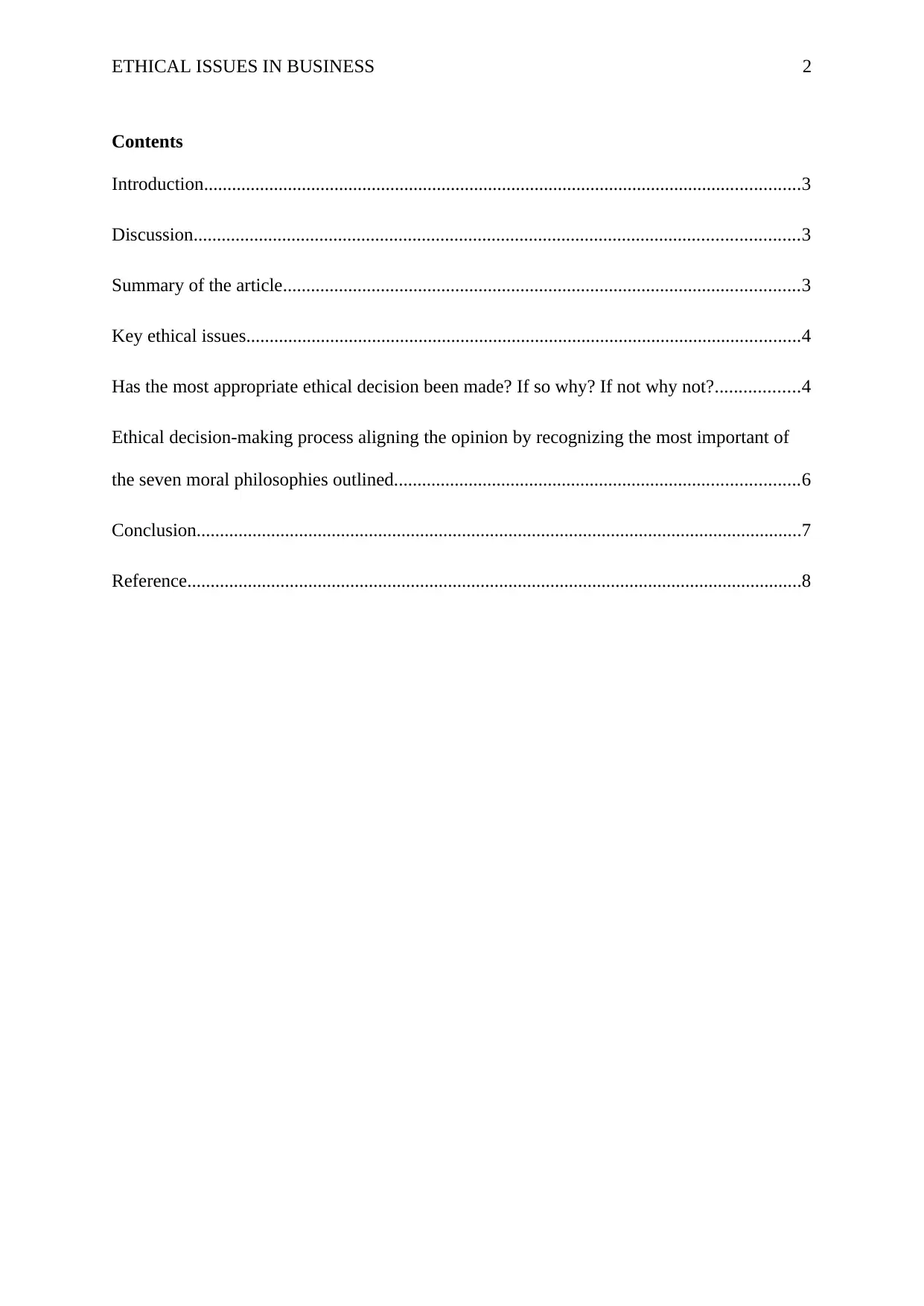
ETHICAL ISSUES IN BUSINESS 2
Contents
Introduction................................................................................................................................3
Discussion..................................................................................................................................3
Summary of the article...............................................................................................................3
Key ethical issues.......................................................................................................................4
Has the most appropriate ethical decision been made? If so why? If not why not?..................4
Ethical decision-making process aligning the opinion by recognizing the most important of
the seven moral philosophies outlined.......................................................................................6
Conclusion..................................................................................................................................7
Reference....................................................................................................................................8
Contents
Introduction................................................................................................................................3
Discussion..................................................................................................................................3
Summary of the article...............................................................................................................3
Key ethical issues.......................................................................................................................4
Has the most appropriate ethical decision been made? If so why? If not why not?..................4
Ethical decision-making process aligning the opinion by recognizing the most important of
the seven moral philosophies outlined.......................................................................................6
Conclusion..................................................................................................................................7
Reference....................................................................................................................................8
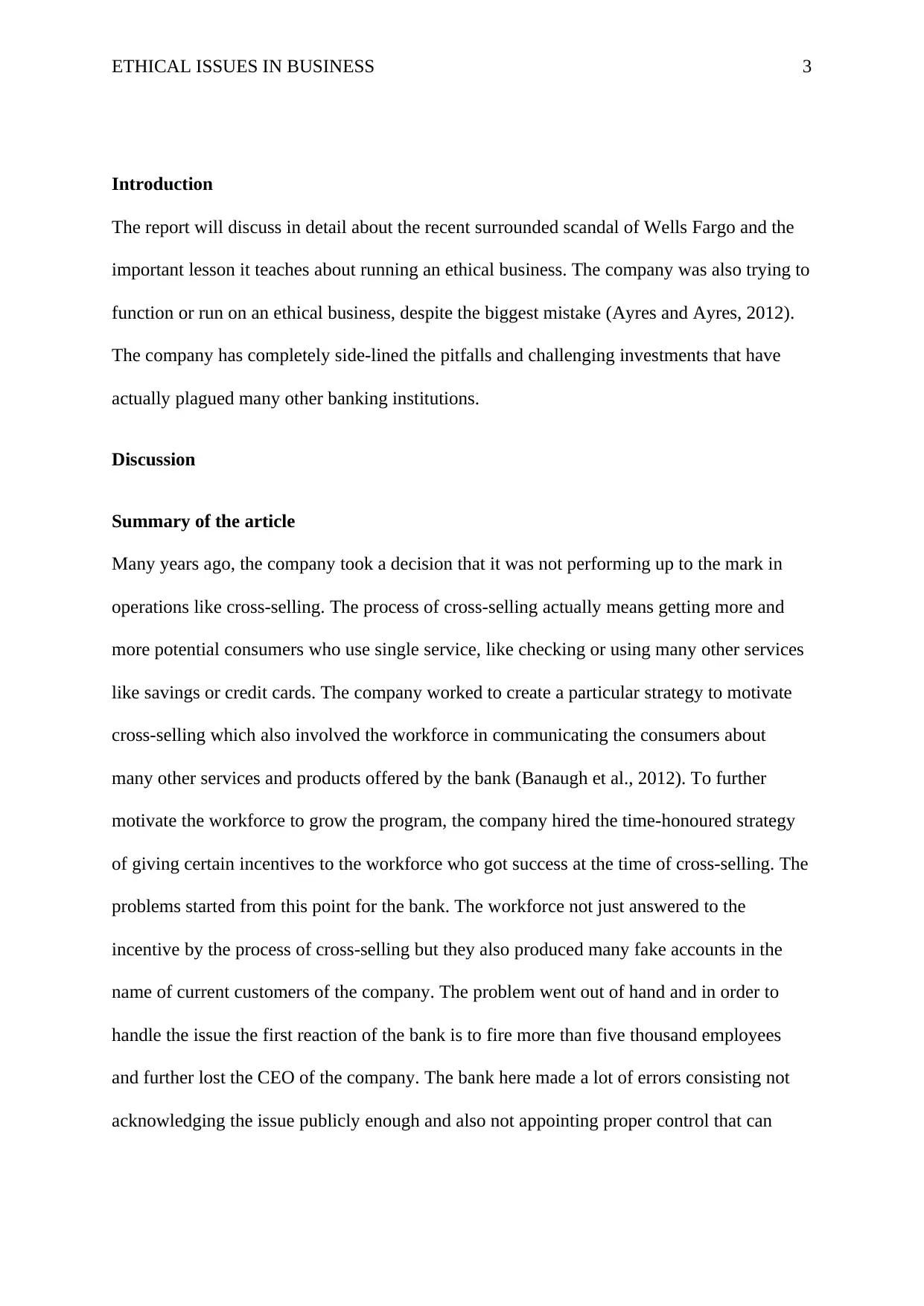
ETHICAL ISSUES IN BUSINESS 3
Introduction
The report will discuss in detail about the recent surrounded scandal of Wells Fargo and the
important lesson it teaches about running an ethical business. The company was also trying to
function or run on an ethical business, despite the biggest mistake (Ayres and Ayres, 2012).
The company has completely side-lined the pitfalls and challenging investments that have
actually plagued many other banking institutions.
Discussion
Summary of the article
Many years ago, the company took a decision that it was not performing up to the mark in
operations like cross-selling. The process of cross-selling actually means getting more and
more potential consumers who use single service, like checking or using many other services
like savings or credit cards. The company worked to create a particular strategy to motivate
cross-selling which also involved the workforce in communicating the consumers about
many other services and products offered by the bank (Banaugh et al., 2012). To further
motivate the workforce to grow the program, the company hired the time-honoured strategy
of giving certain incentives to the workforce who got success at the time of cross-selling. The
problems started from this point for the bank. The workforce not just answered to the
incentive by the process of cross-selling but they also produced many fake accounts in the
name of current customers of the company. The problem went out of hand and in order to
handle the issue the first reaction of the bank is to fire more than five thousand employees
and further lost the CEO of the company. The bank here made a lot of errors consisting not
acknowledging the issue publicly enough and also not appointing proper control that can
Introduction
The report will discuss in detail about the recent surrounded scandal of Wells Fargo and the
important lesson it teaches about running an ethical business. The company was also trying to
function or run on an ethical business, despite the biggest mistake (Ayres and Ayres, 2012).
The company has completely side-lined the pitfalls and challenging investments that have
actually plagued many other banking institutions.
Discussion
Summary of the article
Many years ago, the company took a decision that it was not performing up to the mark in
operations like cross-selling. The process of cross-selling actually means getting more and
more potential consumers who use single service, like checking or using many other services
like savings or credit cards. The company worked to create a particular strategy to motivate
cross-selling which also involved the workforce in communicating the consumers about
many other services and products offered by the bank (Banaugh et al., 2012). To further
motivate the workforce to grow the program, the company hired the time-honoured strategy
of giving certain incentives to the workforce who got success at the time of cross-selling. The
problems started from this point for the bank. The workforce not just answered to the
incentive by the process of cross-selling but they also produced many fake accounts in the
name of current customers of the company. The problem went out of hand and in order to
handle the issue the first reaction of the bank is to fire more than five thousand employees
and further lost the CEO of the company. The bank here made a lot of errors consisting not
acknowledging the issue publicly enough and also not appointing proper control that can
⊘ This is a preview!⊘
Do you want full access?
Subscribe today to unlock all pages.

Trusted by 1+ million students worldwide
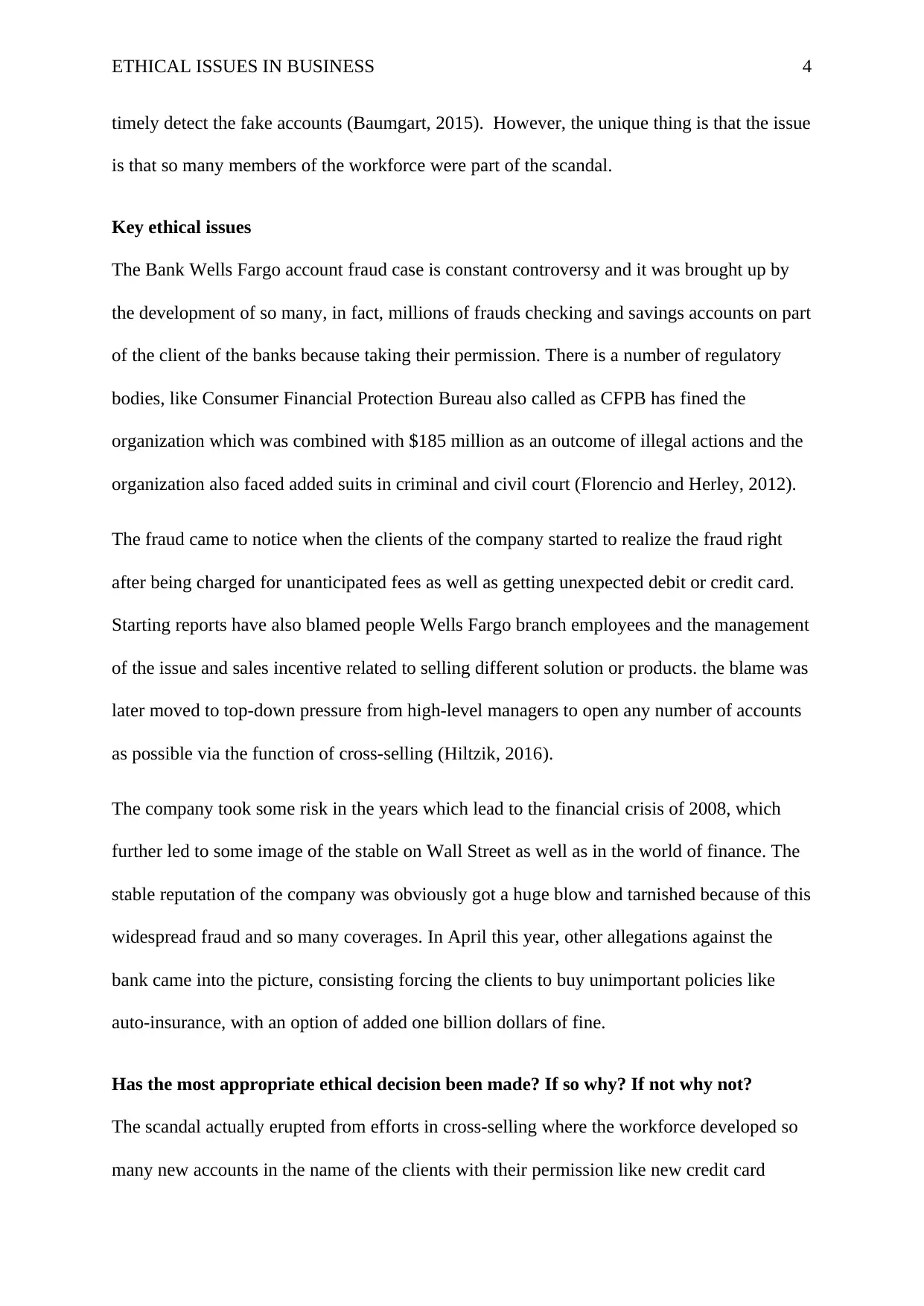
ETHICAL ISSUES IN BUSINESS 4
timely detect the fake accounts (Baumgart, 2015). However, the unique thing is that the issue
is that so many members of the workforce were part of the scandal.
Key ethical issues
The Bank Wells Fargo account fraud case is constant controversy and it was brought up by
the development of so many, in fact, millions of frauds checking and savings accounts on part
of the client of the banks because taking their permission. There is a number of regulatory
bodies, like Consumer Financial Protection Bureau also called as CFPB has fined the
organization which was combined with $185 million as an outcome of illegal actions and the
organization also faced added suits in criminal and civil court (Florencio and Herley, 2012).
The fraud came to notice when the clients of the company started to realize the fraud right
after being charged for unanticipated fees as well as getting unexpected debit or credit card.
Starting reports have also blamed people Wells Fargo branch employees and the management
of the issue and sales incentive related to selling different solution or products. the blame was
later moved to top-down pressure from high-level managers to open any number of accounts
as possible via the function of cross-selling (Hiltzik, 2016).
The company took some risk in the years which lead to the financial crisis of 2008, which
further led to some image of the stable on Wall Street as well as in the world of finance. The
stable reputation of the company was obviously got a huge blow and tarnished because of this
widespread fraud and so many coverages. In April this year, other allegations against the
bank came into the picture, consisting forcing the clients to buy unimportant policies like
auto-insurance, with an option of added one billion dollars of fine.
Has the most appropriate ethical decision been made? If so why? If not why not?
The scandal actually erupted from efforts in cross-selling where the workforce developed so
many new accounts in the name of the clients with their permission like new credit card
timely detect the fake accounts (Baumgart, 2015). However, the unique thing is that the issue
is that so many members of the workforce were part of the scandal.
Key ethical issues
The Bank Wells Fargo account fraud case is constant controversy and it was brought up by
the development of so many, in fact, millions of frauds checking and savings accounts on part
of the client of the banks because taking their permission. There is a number of regulatory
bodies, like Consumer Financial Protection Bureau also called as CFPB has fined the
organization which was combined with $185 million as an outcome of illegal actions and the
organization also faced added suits in criminal and civil court (Florencio and Herley, 2012).
The fraud came to notice when the clients of the company started to realize the fraud right
after being charged for unanticipated fees as well as getting unexpected debit or credit card.
Starting reports have also blamed people Wells Fargo branch employees and the management
of the issue and sales incentive related to selling different solution or products. the blame was
later moved to top-down pressure from high-level managers to open any number of accounts
as possible via the function of cross-selling (Hiltzik, 2016).
The company took some risk in the years which lead to the financial crisis of 2008, which
further led to some image of the stable on Wall Street as well as in the world of finance. The
stable reputation of the company was obviously got a huge blow and tarnished because of this
widespread fraud and so many coverages. In April this year, other allegations against the
bank came into the picture, consisting forcing the clients to buy unimportant policies like
auto-insurance, with an option of added one billion dollars of fine.
Has the most appropriate ethical decision been made? If so why? If not why not?
The scandal actually erupted from efforts in cross-selling where the workforce developed so
many new accounts in the name of the clients with their permission like new credit card
Paraphrase This Document
Need a fresh take? Get an instant paraphrase of this document with our AI Paraphraser
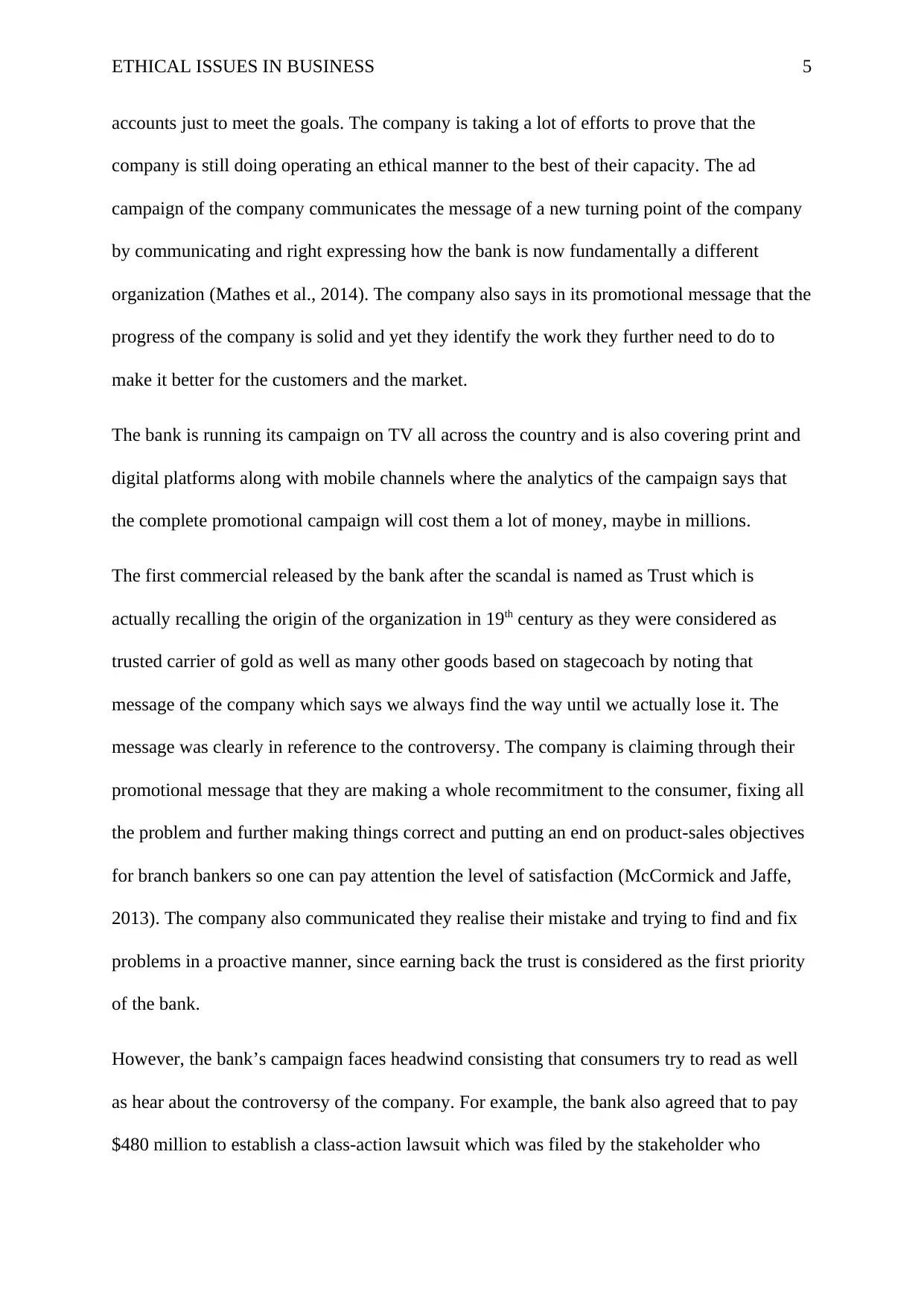
ETHICAL ISSUES IN BUSINESS 5
accounts just to meet the goals. The company is taking a lot of efforts to prove that the
company is still doing operating an ethical manner to the best of their capacity. The ad
campaign of the company communicates the message of a new turning point of the company
by communicating and right expressing how the bank is now fundamentally a different
organization (Mathes et al., 2014). The company also says in its promotional message that the
progress of the company is solid and yet they identify the work they further need to do to
make it better for the customers and the market.
The bank is running its campaign on TV all across the country and is also covering print and
digital platforms along with mobile channels where the analytics of the campaign says that
the complete promotional campaign will cost them a lot of money, maybe in millions.
The first commercial released by the bank after the scandal is named as Trust which is
actually recalling the origin of the organization in 19th century as they were considered as
trusted carrier of gold as well as many other goods based on stagecoach by noting that
message of the company which says we always find the way until we actually lose it. The
message was clearly in reference to the controversy. The company is claiming through their
promotional message that they are making a whole recommitment to the consumer, fixing all
the problem and further making things correct and putting an end on product-sales objectives
for branch bankers so one can pay attention the level of satisfaction (McCormick and Jaffe,
2013). The company also communicated they realise their mistake and trying to find and fix
problems in a proactive manner, since earning back the trust is considered as the first priority
of the bank.
However, the bank’s campaign faces headwind consisting that consumers try to read as well
as hear about the controversy of the company. For example, the bank also agreed that to pay
$480 million to establish a class-action lawsuit which was filed by the stakeholder who
accounts just to meet the goals. The company is taking a lot of efforts to prove that the
company is still doing operating an ethical manner to the best of their capacity. The ad
campaign of the company communicates the message of a new turning point of the company
by communicating and right expressing how the bank is now fundamentally a different
organization (Mathes et al., 2014). The company also says in its promotional message that the
progress of the company is solid and yet they identify the work they further need to do to
make it better for the customers and the market.
The bank is running its campaign on TV all across the country and is also covering print and
digital platforms along with mobile channels where the analytics of the campaign says that
the complete promotional campaign will cost them a lot of money, maybe in millions.
The first commercial released by the bank after the scandal is named as Trust which is
actually recalling the origin of the organization in 19th century as they were considered as
trusted carrier of gold as well as many other goods based on stagecoach by noting that
message of the company which says we always find the way until we actually lose it. The
message was clearly in reference to the controversy. The company is claiming through their
promotional message that they are making a whole recommitment to the consumer, fixing all
the problem and further making things correct and putting an end on product-sales objectives
for branch bankers so one can pay attention the level of satisfaction (McCormick and Jaffe,
2013). The company also communicated they realise their mistake and trying to find and fix
problems in a proactive manner, since earning back the trust is considered as the first priority
of the bank.
However, the bank’s campaign faces headwind consisting that consumers try to read as well
as hear about the controversy of the company. For example, the bank also agreed that to pay
$480 million to establish a class-action lawsuit which was filed by the stakeholder who
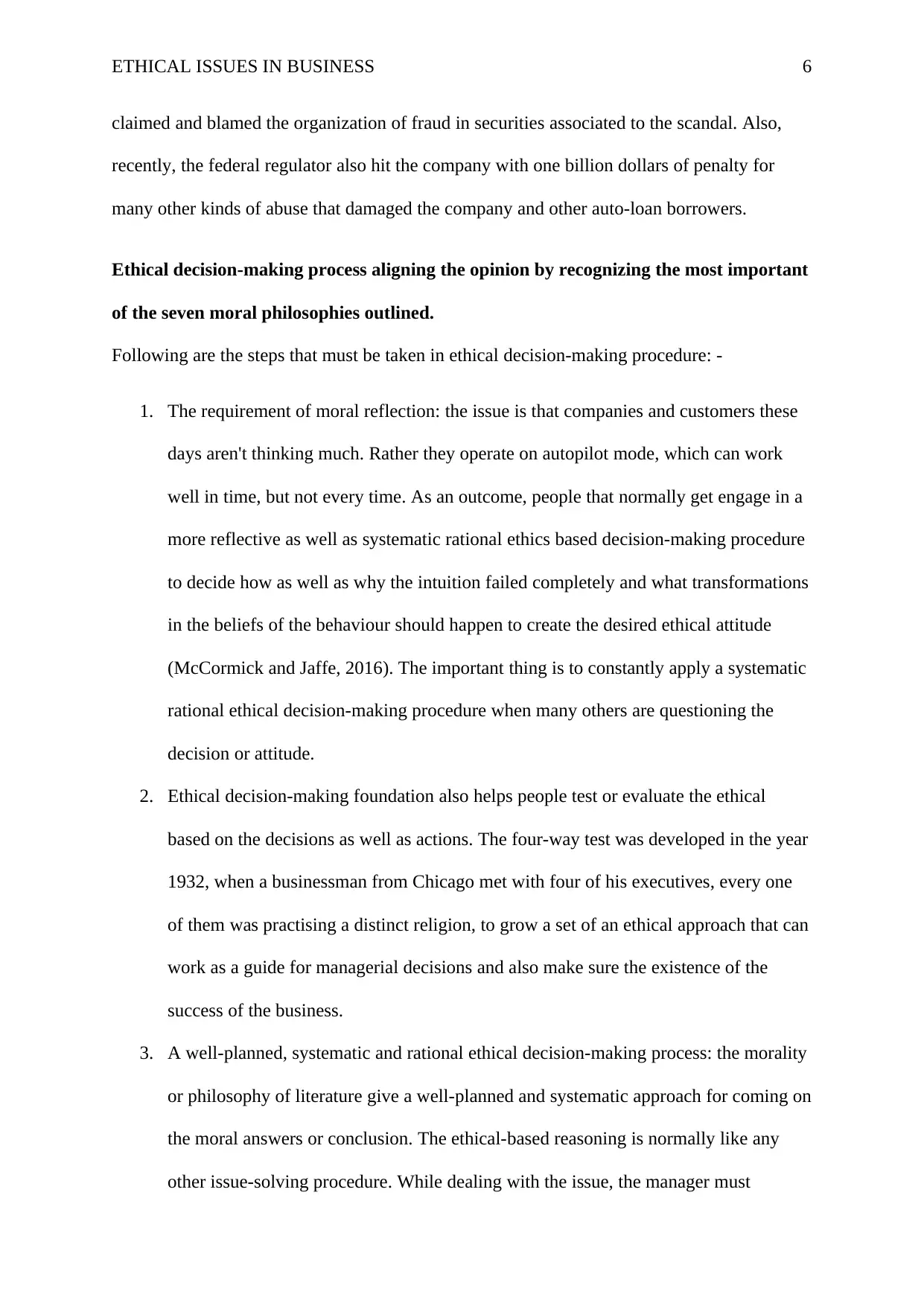
ETHICAL ISSUES IN BUSINESS 6
claimed and blamed the organization of fraud in securities associated to the scandal. Also,
recently, the federal regulator also hit the company with one billion dollars of penalty for
many other kinds of abuse that damaged the company and other auto-loan borrowers.
Ethical decision-making process aligning the opinion by recognizing the most important
of the seven moral philosophies outlined.
Following are the steps that must be taken in ethical decision-making procedure: -
1. The requirement of moral reflection: the issue is that companies and customers these
days aren't thinking much. Rather they operate on autopilot mode, which can work
well in time, but not every time. As an outcome, people that normally get engage in a
more reflective as well as systematic rational ethics based decision-making procedure
to decide how as well as why the intuition failed completely and what transformations
in the beliefs of the behaviour should happen to create the desired ethical attitude
(McCormick and Jaffe, 2016). The important thing is to constantly apply a systematic
rational ethical decision-making procedure when many others are questioning the
decision or attitude.
2. Ethical decision-making foundation also helps people test or evaluate the ethical
based on the decisions as well as actions. The four-way test was developed in the year
1932, when a businessman from Chicago met with four of his executives, every one
of them was practising a distinct religion, to grow a set of an ethical approach that can
work as a guide for managerial decisions and also make sure the existence of the
success of the business.
3. A well-planned, systematic and rational ethical decision-making process: the morality
or philosophy of literature give a well-planned and systematic approach for coming on
the moral answers or conclusion. The ethical-based reasoning is normally like any
other issue-solving procedure. While dealing with the issue, the manager must
claimed and blamed the organization of fraud in securities associated to the scandal. Also,
recently, the federal regulator also hit the company with one billion dollars of penalty for
many other kinds of abuse that damaged the company and other auto-loan borrowers.
Ethical decision-making process aligning the opinion by recognizing the most important
of the seven moral philosophies outlined.
Following are the steps that must be taken in ethical decision-making procedure: -
1. The requirement of moral reflection: the issue is that companies and customers these
days aren't thinking much. Rather they operate on autopilot mode, which can work
well in time, but not every time. As an outcome, people that normally get engage in a
more reflective as well as systematic rational ethics based decision-making procedure
to decide how as well as why the intuition failed completely and what transformations
in the beliefs of the behaviour should happen to create the desired ethical attitude
(McCormick and Jaffe, 2016). The important thing is to constantly apply a systematic
rational ethical decision-making procedure when many others are questioning the
decision or attitude.
2. Ethical decision-making foundation also helps people test or evaluate the ethical
based on the decisions as well as actions. The four-way test was developed in the year
1932, when a businessman from Chicago met with four of his executives, every one
of them was practising a distinct religion, to grow a set of an ethical approach that can
work as a guide for managerial decisions and also make sure the existence of the
success of the business.
3. A well-planned, systematic and rational ethical decision-making process: the morality
or philosophy of literature give a well-planned and systematic approach for coming on
the moral answers or conclusion. The ethical-based reasoning is normally like any
other issue-solving procedure. While dealing with the issue, the manager must
⊘ This is a preview!⊘
Do you want full access?
Subscribe today to unlock all pages.

Trusted by 1+ million students worldwide
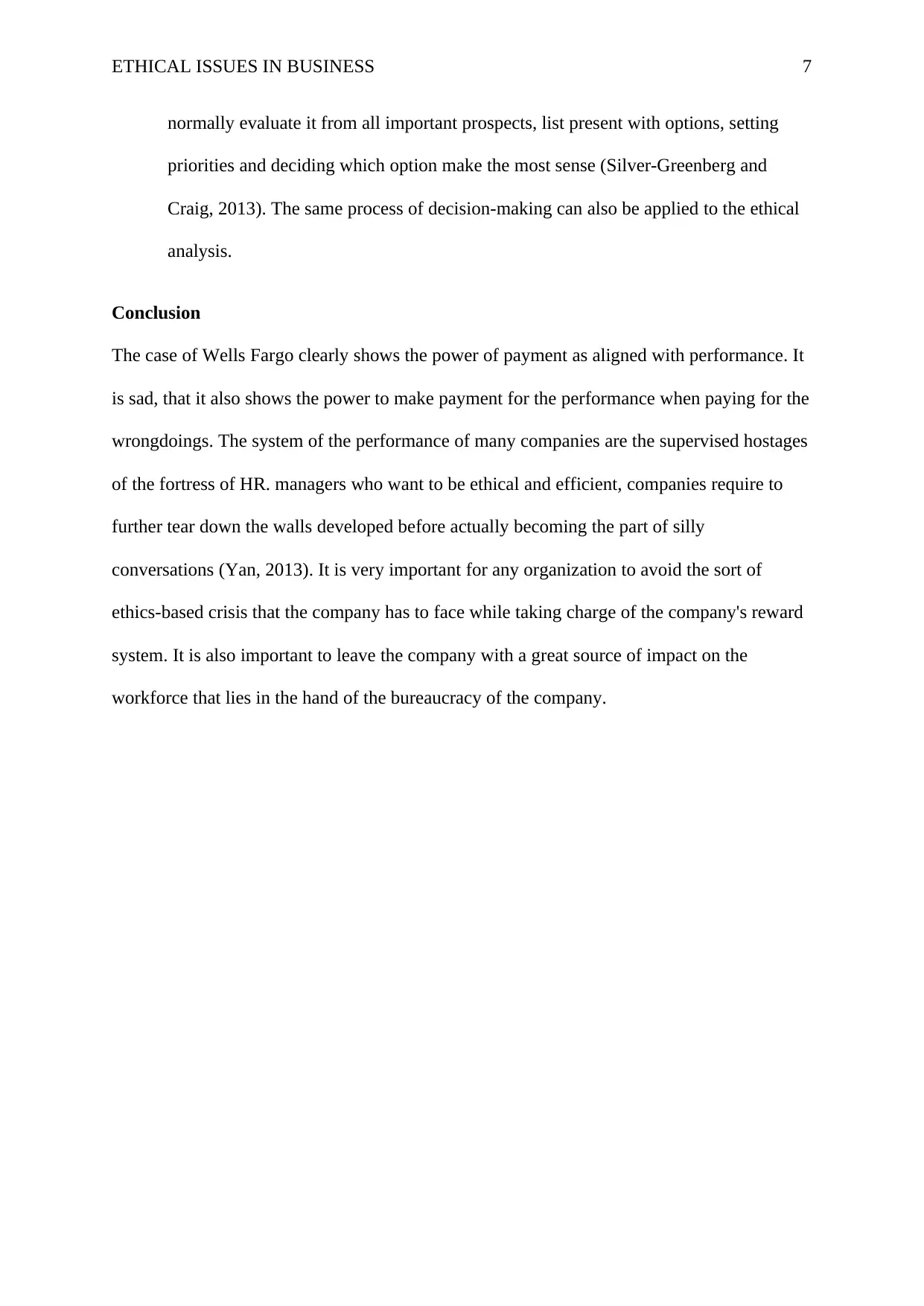
ETHICAL ISSUES IN BUSINESS 7
normally evaluate it from all important prospects, list present with options, setting
priorities and deciding which option make the most sense (Silver-Greenberg and
Craig, 2013). The same process of decision-making can also be applied to the ethical
analysis.
Conclusion
The case of Wells Fargo clearly shows the power of payment as aligned with performance. It
is sad, that it also shows the power to make payment for the performance when paying for the
wrongdoings. The system of the performance of many companies are the supervised hostages
of the fortress of HR. managers who want to be ethical and efficient, companies require to
further tear down the walls developed before actually becoming the part of silly
conversations (Yan, 2013). It is very important for any organization to avoid the sort of
ethics-based crisis that the company has to face while taking charge of the company's reward
system. It is also important to leave the company with a great source of impact on the
workforce that lies in the hand of the bureaucracy of the company.
normally evaluate it from all important prospects, list present with options, setting
priorities and deciding which option make the most sense (Silver-Greenberg and
Craig, 2013). The same process of decision-making can also be applied to the ethical
analysis.
Conclusion
The case of Wells Fargo clearly shows the power of payment as aligned with performance. It
is sad, that it also shows the power to make payment for the performance when paying for the
wrongdoings. The system of the performance of many companies are the supervised hostages
of the fortress of HR. managers who want to be ethical and efficient, companies require to
further tear down the walls developed before actually becoming the part of silly
conversations (Yan, 2013). It is very important for any organization to avoid the sort of
ethics-based crisis that the company has to face while taking charge of the company's reward
system. It is also important to leave the company with a great source of impact on the
workforce that lies in the hand of the bureaucracy of the company.
Paraphrase This Document
Need a fresh take? Get an instant paraphrase of this document with our AI Paraphraser
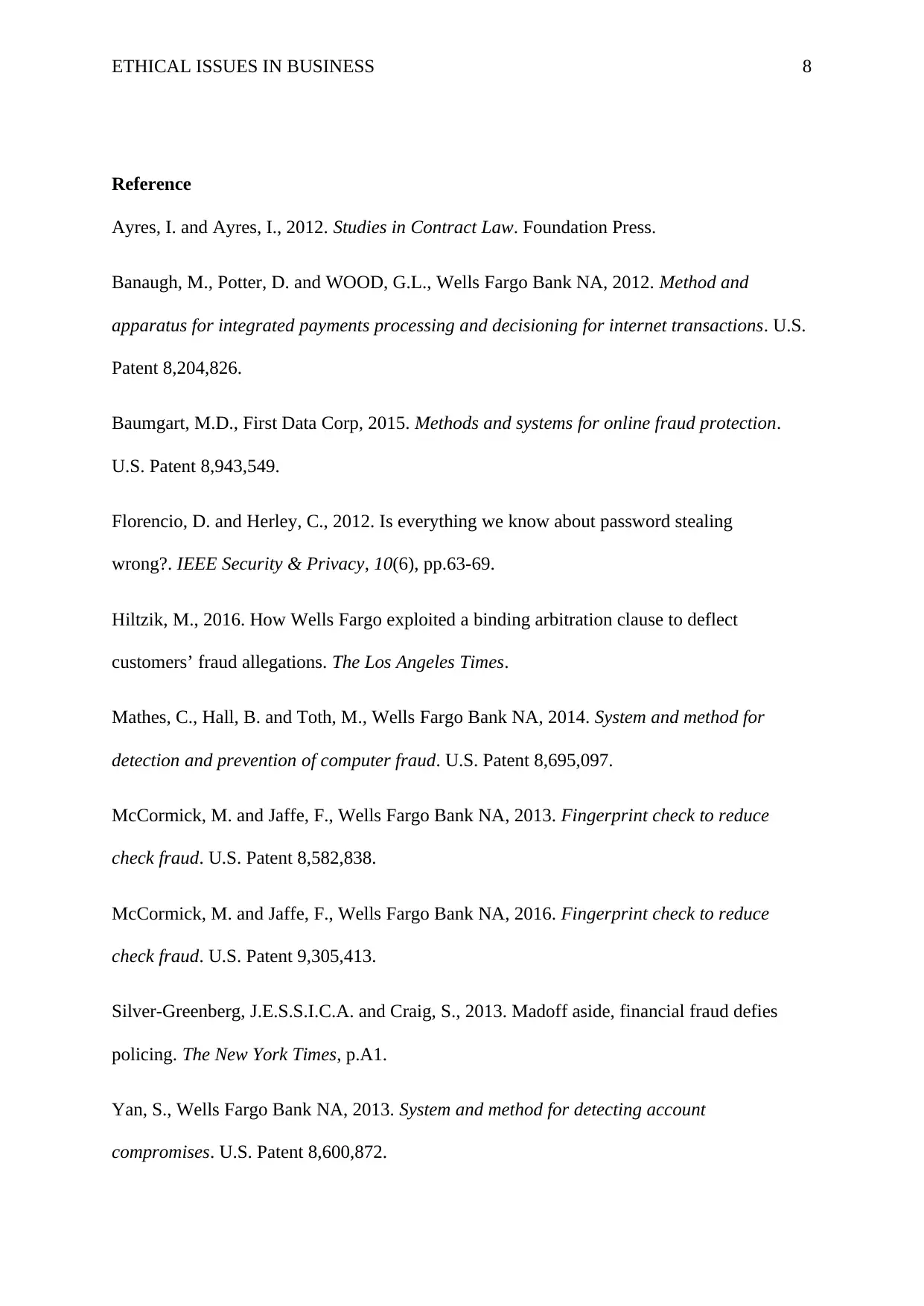
ETHICAL ISSUES IN BUSINESS 8
Reference
Ayres, I. and Ayres, I., 2012. Studies in Contract Law. Foundation Press.
Banaugh, M., Potter, D. and WOOD, G.L., Wells Fargo Bank NA, 2012. Method and
apparatus for integrated payments processing and decisioning for internet transactions. U.S.
Patent 8,204,826.
Baumgart, M.D., First Data Corp, 2015. Methods and systems for online fraud protection.
U.S. Patent 8,943,549.
Florencio, D. and Herley, C., 2012. Is everything we know about password stealing
wrong?. IEEE Security & Privacy, 10(6), pp.63-69.
Hiltzik, M., 2016. How Wells Fargo exploited a binding arbitration clause to deflect
customers’ fraud allegations. The Los Angeles Times.
Mathes, C., Hall, B. and Toth, M., Wells Fargo Bank NA, 2014. System and method for
detection and prevention of computer fraud. U.S. Patent 8,695,097.
McCormick, M. and Jaffe, F., Wells Fargo Bank NA, 2013. Fingerprint check to reduce
check fraud. U.S. Patent 8,582,838.
McCormick, M. and Jaffe, F., Wells Fargo Bank NA, 2016. Fingerprint check to reduce
check fraud. U.S. Patent 9,305,413.
Silver-Greenberg, J.E.S.S.I.C.A. and Craig, S., 2013. Madoff aside, financial fraud defies
policing. The New York Times, p.A1.
Yan, S., Wells Fargo Bank NA, 2013. System and method for detecting account
compromises. U.S. Patent 8,600,872.
Reference
Ayres, I. and Ayres, I., 2012. Studies in Contract Law. Foundation Press.
Banaugh, M., Potter, D. and WOOD, G.L., Wells Fargo Bank NA, 2012. Method and
apparatus for integrated payments processing and decisioning for internet transactions. U.S.
Patent 8,204,826.
Baumgart, M.D., First Data Corp, 2015. Methods and systems for online fraud protection.
U.S. Patent 8,943,549.
Florencio, D. and Herley, C., 2012. Is everything we know about password stealing
wrong?. IEEE Security & Privacy, 10(6), pp.63-69.
Hiltzik, M., 2016. How Wells Fargo exploited a binding arbitration clause to deflect
customers’ fraud allegations. The Los Angeles Times.
Mathes, C., Hall, B. and Toth, M., Wells Fargo Bank NA, 2014. System and method for
detection and prevention of computer fraud. U.S. Patent 8,695,097.
McCormick, M. and Jaffe, F., Wells Fargo Bank NA, 2013. Fingerprint check to reduce
check fraud. U.S. Patent 8,582,838.
McCormick, M. and Jaffe, F., Wells Fargo Bank NA, 2016. Fingerprint check to reduce
check fraud. U.S. Patent 9,305,413.
Silver-Greenberg, J.E.S.S.I.C.A. and Craig, S., 2013. Madoff aside, financial fraud defies
policing. The New York Times, p.A1.
Yan, S., Wells Fargo Bank NA, 2013. System and method for detecting account
compromises. U.S. Patent 8,600,872.
1 out of 8
Related Documents
Your All-in-One AI-Powered Toolkit for Academic Success.
+13062052269
info@desklib.com
Available 24*7 on WhatsApp / Email
![[object Object]](/_next/static/media/star-bottom.7253800d.svg)
Unlock your academic potential
Copyright © 2020–2025 A2Z Services. All Rights Reserved. Developed and managed by ZUCOL.



